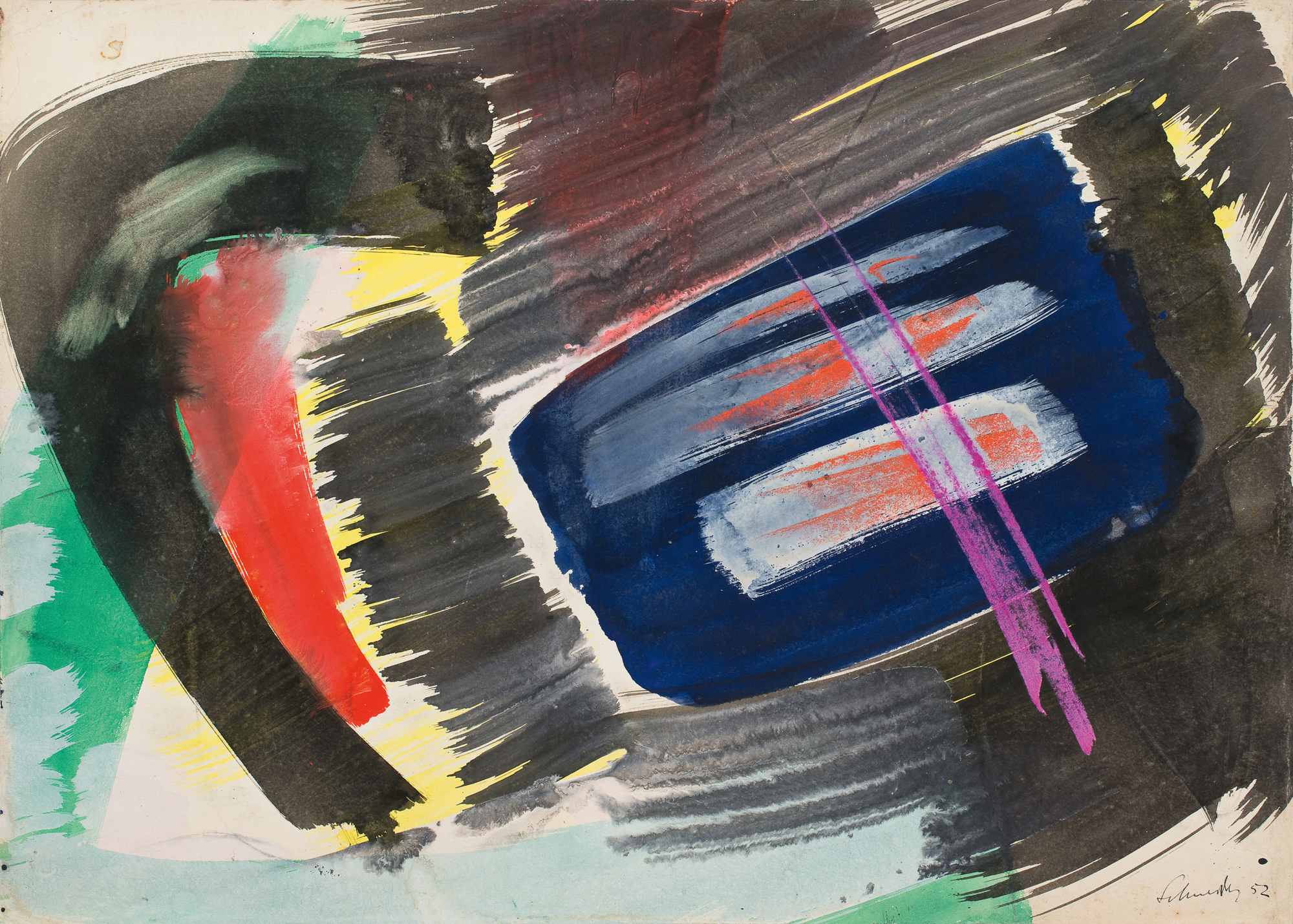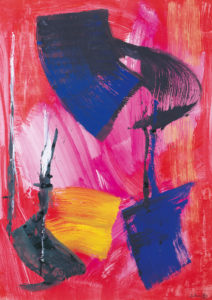Gérard SCHNEIDER
The Emergence of Gesture
EXHIBITION AT THE GALLERY UNTIL DECEMBER 18, 2020

UNTITLED, 1952
37,5 x 52,5 cm / 14 3/4 x 20 11/16 in.
Gouache, India ink and pastel on paper
Signed and dated ‘Schneider 52’ lower right
Diane de Polignac Gallery, Paris
This exhibition focuses on a support: paper, and a period: from 1944 to 1959, or fifteen years of intense work by the painter Gérard Schneider, during which the artist goes from a laboratory of forms and colors to the confidence of a calligraphic gesture.
The post-war period formed a crucial juncture in Gérard Schneider’s work, confirming abstraction as the only possible creative path for the artist. Breaking with the pioneers of the abstract movement active in the first half of the 20th century, Schneider embraced a new form of abstraction—gestural abstraction.
It is the very emergence of gesture in the artist’s works—and the establishment of this creative language—that these works invite the viewer to discover. Slowly, the structures inherited from geometrical traditions appear to fade away, giving way to lyricism.
Through a selection of more than seventy works, the exhibition highlights the importance of this period in Schneider’s work and the meaningful nature of his aesthetic choices, providing a unique perspective on the artist’s painted works through his works on paper.

UNTITLED, 1951
47,5 x 62,9 cm / 18 11/16 x 24 3/4 in.
Gouache, India ink and pastel on paper
Signed and dated ‘Schneider – 51’ lower left
Diane de Polignac Gallery, Paris
“Art does not reproduce the visible but makes visible.” It is with this famous phrase that Paul Klee opens a chapter, The Creative Credo, in his book on The Theory of Modern Art. A collection of his writings from the 1920s, this publication establishes the fundamentals of modern art, in particular the theoretical foundations for abstraction in painting. According to Paul Klee, the role of art is not so much to imitate or reproduce nature, but instead to reveal it.
By 1944, the painter Gérard Schneider’s choice had already been made a few years beforehand: abstraction was the path he took to pursue his artistic quest.

UNTITLED, 1944
31 x 24 cm / 12 3/16 x 9 7/16 in.
Charcoal and pastel on grey paper
Signed and dated ‘Schneider 44’ lower right
Diane de Polignac Gallery, Paris
During those years marked by the end of global conflict, confronting reality and transcribing it into art was a central issue. What could the subject of art be? If we consider Paul Klee’s point of view again, the work of art extends our perception of the world beyond ourselves. It thus renders the world more visible and can in a way demonstrate the invisible.

UNTITLED, 1950
37,5 x 52,5 cm / 14 3/4 x 20 11/16 in.
India ink and pastel on paper
Signed and dated ‘Schneider / – 50’ lower left
Diane de Polignac Gallery, Paris
Having learned from Cézanne and Kandinsky, and more generally from the avant-garde artists of the first half of the 20th century, the artist Gérard Schneider from then on would tirelessly explore these infinite possibilities that were offered to him. In this fundamental episode of the history of art, his travelling companions were major artists such as Hans Hartung, Pierre Soulages, and Georges Mathieu. Bridges are made from one artist to another, as one can see in this artwork from 1952 illustrated below. This is how at that time in Paris, with these artists who were accompanied by enthusiastic gallerists and art critics, lyrical abstraction was born.

UNTITLED, 1952
45,7 x 64 cm / 18 x 25 3/16 in.
Gouache, India ink and pastel on paper
Signed and dated ‘Schneider II/52’ lower right
Diane de Polignac Gallery, Paris
These works guide us over a period of fifteen years, alongside the painter Gérard Schneider, in a sort of proximity and intimacy that allow us to glimpse the original mechanics of the creative process. The small format ones – like real miniatures – explore and question the issues raised by classical composition.

UNTITLED, 1949
31,5 x 23,7 cm / 12 3/8 x 9 5/16 in.
Gouache on paper
Signed and dated ‘Schneider /
49’ lower right
Diane de Polignac Gallery, Paris

UNTITLED, 1949 ca.
30,8 x 23,5 cm / 121/8 x 91/4 in.
Charcoal and pastel on
paper
Signed ‘Schneider’ lower
right
Diane de Polignac Gallery, Paris
The absolute freedom with which his work on paper is synonymous can be glimpsed through the variety of supports and techniques. In larger works, it is the confrontation of the full and the void that culminates with the creation of audacious and radical compositions.

UNTITLED, 1948
48 x 60,8 cm / 18 7/8 x 23 15/16 in.
Pencil and pastel on paper
Signed and dated ‘Schneider 48’ lower right
Diane de Polignac Gallery, Paris
From reminiscences of a geometrical analysis of the visual space to the appearance of a clearly calligraphic gesture, this transitional period is illustrated fully and given its rightful place.

UNTITLED, 1948 ca.
31,5 x 24 cm / 12 3/8 x 9 7/16 in.
Charcoal and pastel on paper
Signed ‘Schneider’ lower right
Diane de Polignac Gallery, Paris
It is essential to re-examine this notion of gesture – isn’t it called gestural abstraction elsewhere? – this spontaneous gesture, an eruption that beyond all prior mental construction, has its own existence, its own reality: it is autonomous. In the confrontation with the canvas, a “resistance” of the material can survive, of the constraints that can create a gap between the initial gesture and the finished work. In the case of paper used as a support; the situation is completely different, the gesture is inscribed, raw and untouched, on the sheet. It enables the absence of premeditation that is a foundation of the artist painter Gérard Schneider’s abstraction.

UNTITLED, 1949
47,2 x 62,9 cm / 18 9/16 x 24 3/4 in.
Charcoal and pastel on paper
Signed and dated ‘Schneider – 49 – 9’ lower right
Diane de Polignac Gallery, Paris
Very quickly this force and veracity, which working on paper allows, would lead Gérard Schneider to radicalize and simplify his gesture.

UNTITLED, 1949 ca.
33 x 25 cm / 13 x 9 13/16 in.
Charcoal and pastel on paper
Diane de Polignac Gallery, Paris
From the mid-1950s, his inks acquired a truly calligraphic dimension. This free and controlled gesture formed a perfect pendant to his overall process through which he intended to incarnate in the precise instant of painting – the gesture – the invisible reality of emotions and psyche: a true lyric.

UNTITLED, 1955 ca.
13,5 x 20,8 cm / 5 5/16 x 8 3/16 in.
India ink on paper
Diane de Polignac Gallery, Paris
A parallel should of course be formed between his personal approach to calligraphy and the enthusiasm with which the artist painter Gérard Schneider’s work was greeted in Japan from this period and the many exchanges with Japanese art critics and calligraphers, as with this charcoal artwork reproduced in the art magazine Bokubi.

UNTITLED, 1948
48,5 x 63 cm / 19 1/16 x 24 13/16 in.
Charcoal on paper
Signed and dated ‘Schneider – 48’ lower right
Diane de Polignac Gallery, Paris

BOKUBI Magazine, n°37, September 1954. Article by Itsuji
Yoshikawa presenting the work of Gérard Schneider.
© Archives Gérard Schneider.
In Gérard Schneider’s practice, the work on paper is not in itself an anticipation of the canvas: it is complementary and parallel to it and does not fit into the same time. The work on paper precedes and succeeds the canvas and is not a “repetition” in any way; rather it is a space – an instant – of freedom that will allow and then echo the confrontation with the canvas. Paper is a permanence in time allowing a group of forms, signs and colored confrontations to be available and in perpetual evolution. The space of the sheet of paper can be considered as the physical space of a laboratory, of this factory for visual elements that comprises the art of the painter Gérard Schneider.

UNTITLED, 1951
45 x 62,7 cm / 17 3/4 x 24 11/16 in.
Gouache and India ink on paper
Signed and dated ‘Schneider / -51’ lower left
Diane de Polignac Gallery, Paris

UNTITLED, 1951
48 x 63 cm / 18 7/8 x 24 13/16 in.
Gouache, India ink and pastel on paper
Signed and dated ‘Schneider / -51’ lower left
Diane de Polignac Gallery, Paris
Schneider always knew how important a place this paper support should have in the presentation of his work to the public. Throughout his career, he chose to conceive exhibitions including or presenting works on paper alone. Although major exhibitions have shown his paintings magnificently (in Brussels in 1953 and in 1962, at the Kootz Gallery New York from 1956 to 19561, in Dusseldorf in 1962 and in Turin in 1970), other exhibitions have specifically highlighted the works on paper: shows at the Galerie Louis Carré in 1951 (with Hans Hartung and André Lanskoy), at the Galerie de Beaune in 1951 and at the Galerie Im Erker in Saint-Gall in 1961 and 1963 are a few examples.

UNTITLED, 1951
22 x 18 cm / 8 11/16 x 7 1/16 in.
Gouache and India ink on paper
Signed and dated ‘Schneider – 51’ lower left
Inscribed ‘P425’ lower right
Signed ‘Schneider’ on reverse
Diane de Polignac Gallery, Paris
The final decade of his life should also be mentioned. A decade during which the work on paper took over the larger part of his activity. With the contribution of acrylic paint at the end of the 1960s, color acquired a presence and force that had rarely been equalled before. In addition, the speed of execution that this allowed him enabled the gesture to be completely liberated and it is therefore around the mid-1970s that the production on paper took on a magnitude that had never been known before. The highlight was the start of the 1980s when, retaining the specificities of working on paper, he returned to using large formats, in this way creating rare and intense works.

UNTITLED, 1983
149 x 107 cm / 48.5 x 42.1 in.
Acrylic on paper
Collection Frac Île-de-France, Paris

UNTITLED, 1959
52,7 x 74,3 cm / 20 3/4 x 29 1/4 in.
India ink and pastel on paper
Signed and dated ‘Schneider / 9-59’ lower left
Diane de Polignac Gallery, Paris
In the painter Gérard Schneider’s body of work, creation on paper from the 1940s-1950s is a pivotal step in the affirmation of the calligraphic and spontaneous gesture as a key process of an unplanned creation, a fundamental milestone in Gérard Schneider’s Lyrical Abstraction.
Christian Demare and Astrid de Monteverde
© Christian Demare / Astrid de Monteverde / Diane de Polignac Gallery, 2020
